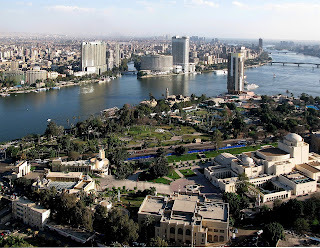I promised Harris some free time so he could finish his work
(now weighing in just under 300 pages on one topic and 130 on another) before
we took off. It’s part of my Cairo Bucket List project. Emad and I went off on
Saturday for a boondoggle to view sites I knew Harris was not hellbent on
seeing. Our first stop was the Museum of Islamic Ceramics in Zamalek, an
obscure museum in a beautiful 1920s villa of Islamic style architecture
surrounded by gardens. It was closed for renovations. Phooey.
Our next try was the Manial Palace, built by a rich family
member of Mohammed Ali’s in the late 1800s. I’d seen it in 1996, and liked it
for how each room represented one of the decorative traditions of Islam. It,
too, was closed for renovations.
Next try was the Cairo Tower, built in 1961 under Nasser
with money from the U.S. that was, according to my guidebook, earmarked for
buying American arms. Instead, he had a tall needle constructed with a
distinctive basket-weave shell. The view from the top was splendid: all of
greater Cairo was laid out before me, from the Pyramids to Moqattam Hills. I
circled around twice and realized that as I gazed and recognized various
places, it made me blue. Time to descend.
 |
| Cairo Tower, with its distinctive basket-weave exterior |
 |
| View looking south |
After a bit of koshery at Abu Hanafy’s, Emad and I went to Coptic
Cairo. Though the weather had turned hot, we trekked around tirelessly. First
stop was the Church of Saint George, martyred under Emperor Diocletian for his
Christian beliefs, but better known for slaying a dragon. The spaces were small
and a little smelly.
 |
| Mosaic of Saint George at the church |
From there, we walk through the pedestrian-only covered
alleys of Coptic Cairo to the church of Saint Sergius, built (according to
legend) over a cave where Mary, Joseph, and Jesus hid from Herod’s slaughter of
the innocents in their flight from Jerusalem into Egypt. Like all the churches
in the area, it is basilica-style, and combines decorative motifs from Islamic
art with Christian iconography.
 |
| Pedestrian-only alleys of Coptic Cairo |
 |
| Exquisite inlay at Saint Sergius |
Saint Barbara’s was next, as well as a walk through the
Greek Orthodox cemetery, remarkably beautiful even in the hot sun. We stopped
in the Hanging Church, built over a water gate, visible through a glass slit in
the floor. A group of Indonesian Christians wearing baseball caps with
“Holyland Tour” stitched on them livened it up.
 |
| Hanging Church from the air; note the Roman walls in the background |
The most interesting place to me was something unexpected,
the Ben Ezra Synagogue. It is one of the oldest in the world, built first in
350 BC, rebuilt under Ibn Tulun (whose mosque we saw last week) in the 9th
century, and restored by the Supreme Council of Antiquities and the Canadian
Center for Architecture in the 1990s. It, too, is basilica-style, and for a
period functioned as a Coptic church; two small confessional rooms on either
side of the altar where the Torah is kept are still there.
Ben Ezra’s carefully restored decoration fuses the
decorative traditions of the three Abrahamic religions as well as ancient
Egypt. There is a well where the daughter of Pharoah found Moses (the Nile was
closer then); the altar is decorated with exquisite inlays in mother of pearl and
ivory of arabesques in traditional Islamic designs; the basilica format is
Christian; and Hebrew and Arabic inscriptions give the name of God. In 1896, a
treasure trove of written materials were found, a geniza (funeral) stash; since anything with the name of God written
on it can not be destroyed, these documents were “buried.” They now reside at
Cambridge University, and include a letter from Maimonides, deeds of sale,
parts of ancient torahs, and various documents dating from medieval Cairo to
the end of the 19th century.
 |
| Interior of Ben Ezra |
 |
| Fragment from Ben Ezra's geniza |
When we returned to Ma’adi after this wonderful outing (with
a stop en route to buy two large suitcases—we are probably bringing eight
checked bags home)—Harris had crunched a huge amount of work, so my junket
served its purpose.
The president of Bryn Mawr College, my alma mater, came to
AUC on Sunday and I joined other Mawrters for a lunch in her honor. Jane
MacAuliffe’s specialty is Islamic studies and cross-religious studies; she was
in town for one day en route to a festschrift
(essentially, a festival of scholarly papers) honoring an archbishop with whom
she had worked, and put Cairo on her itinerary. It was fun.
I pick up my students’ final work tomorrow, and then spend
the 23rd and 24th grading as Egypt votes. All eyes are on
this election. Jimmy Carter is coming to town, and there is a chance we will
get passes to hear him speak on Saturday. I’ll post again after the elections.
We live in interesting times. BTW, all my photos in this posting are from the
internet; my camera is messing up.
No comments:
Post a Comment